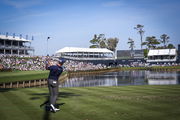
Imago
Courtesy: IMAGO

Imago
Courtesy: IMAGO
Imagine spending your entire life perfecting a skill, only to have luck completely override your expertise. That’s exactly what happened at Quail Hollow this week. Golf is supposed to reward precision and skill, right? Well, not always. After four inches of rain soaked the course last week, something unusual happened. Players started hitting perfect drives down the middle of the fairways. And then watching in horror as their approaches went completely haywire.
Watch What’s Trending Now!
The culprit? Mud balls. Lots of them. Players are fuming. Fans are confused. Even the typically diplomatic commentators are raising eyebrows. It’s quickly becoming the story of this year’s PGA Championship.
Top Stories
Who Is Charley Hull’s Ex-Husband? Is LPGA Star Currently Dating?

Pro Suffers Disqualification at PGA Tour Q-School After Several Players Withdrew Abruptly

Golf World Feels Sorry for PGA Tour Hopeful as Meltdown Over Q-School Stress Is Caught on Camera

Brooks Koepka Takes up New Role Amid LIV Golf Exit Rumors Reaching Boiling Point

Donald Trump Puts Public Golf Courses on Notice Amid Control Dispute

ADVERTISEMENT
PGA’s shortsighted decision backfires spectacularly
“The storyline today was, and this is fantastic, it was millionaires complaining about mud balls,” Rex explained on The Golf Channel Podcast with Rex and Lav. The controversy began before a single shot was hit. The PGA of America issued a preemptive bulletin on Wednesday evening stating, “We do not plan to play preferred lies.” They insisted playing surfaces were “outstanding” and “drying by the hour.”
Lav noted this preemptive announcement was extraordinary. “I don’t ever remember tournament officials basically issuing a preemptive strike,” he said. It was almost as if they anticipated complaints. And those complaints came quickly once play began.
The supergroup of Scottie Scheffler, Rory McIlroy, and Xander Schauffele became the perfect example of how this decision backfired. Both Scheffler and Schauffele hit brilliant drives on the 16th hole – 322-yard tee shots right down the middle of the fairway. Then disaster struck. Both players snap-hooked their approach shots directly into the water hazard.
ADVERTISEMENT
“That’s never going to happen in any universe under any circumstances unless there were mud balls,” Rex explained. These are two of the game’s premier ball-strikers. Yet both watched helplessly as mud completely negated their skills.
Scottie Scheffler spoke passionately after his round about the conditions. “I understand how a golf purist would be, oh, play it as it lies,” he acknowledged. But he quickly countered this traditionalist view. “I don’t think they understand what it’s like literally working your entire life to learn how to hit a golf ball,” he added. Having that control suddenly taken away feels deeply unfair.
ADVERTISEMENT
View this post on Instagram
“It was shortsighted,” Rex emphasized repeatedly during the podcast discussion. The PGA’s stance directly contradicts their own mantra of identifying the week’s best player. Even ESPN broadcaster Curtis Strange didn’t mince words. “They were wrong, obviously,” he stated bluntly during the coverage. “I think they made a mistake.”
But what exactly happens when mud attaches to a golf ball? Why does it cause such havoc for even the world’s best players? The explanation lies in introductory physics and aerodynamics that no amount of skill can overcome.
ADVERTISEMENT
PGA 2025, Quail Hollow and the science behind the maddening unpredictability
Mud creates a significant weight imbalance on the ball, making shot control nearly impossible. The physics is quite simple yet devastating for players. When mud attaches to one side, it shifts the center of gravity, dramatically affecting aerodynamics. The ball no longer spins symmetrically through the air. Instead, it curves unpredictably based on mud placement.
Research by Dr. Paul Wood reveals startling results about distance loss. A clean ball hit with a 4-iron travels about 220 yards under normal conditions. Add mud to either side, and the distance drops by over 20 yards. Place mud on the back, and you’ll lose a staggering 70 yards from your shot.
ADVERTISEMENT
The mud’s position constantly shifts during play, creating a maddening reassessment after each shot. Players face a strategic dilemma—launch high for distance but risk more mud, or hit low to potentially “clean” the ball but sacrifice yards. Quail Hollow’s current “perfect cake zone” conditions feature soft subsurfaces collecting mud while the drier top layer ensures it sticks persistently—a problem that typically intensifies as tournaments progress.
Major championships should identify the best player through skill, not luck. Yet at Quail Hollow, we’re watching the world’s best golfers battle the course and the arbitrary effects of mud balls. This PGA Championship might ultimately be decided by random mud collection rather than brilliant shot-making. What do you think—should preferred lies be mandatory when conditions clearly warrant them?
ADVERTISEMENT
ADVERTISEMENT
ADVERTISEMENT

